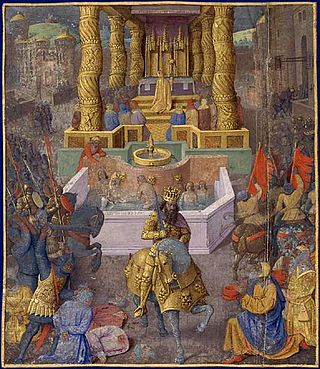
Alexander Jannaeus was the second king of the Hasmonean dynasty, who ruled over an expanding kingdom of Judaea from 103 to 76 BCE. A son of John Hyrcanus, he inherited the throne from his brother Aristobulus I, and married his brother's widow, Queen Salome Alexandra. From his conquests to expand the kingdom to a bloody civil war, Alexander's reign has been generalised as cruel and oppressive with never-ending conflict. The major historical sources of Alexander's life are Josephus's Antiquities of the Jews and The Jewish War.

Herod I or Herod the Great was a Roman Jewish client king of the Herodian Kingdom of Judea. He is known for his colossal building projects throughout Judea. Among these works are the rebuilding of the Second Temple in Jerusalem and the expansion of its base—the Western Wall being part of it. Vital details of his life are recorded in the works of the 1st century CE Roman–Jewish historian Josephus.

The Hasmonean dynasty was a ruling dynasty of Judea and surrounding regions during the Hellenistic times of the Second Temple period, from c. 140 BCE to 37 BCE. Between c. 140 and c. 116 BCE the dynasty ruled Judea semi-autonomously in the Seleucid Empire, and from roughly 110 BCE, with the empire disintegrating, Judea gained further autonomy and expanded into the neighboring regions of Perea, Samaria, Idumea, Galilee, and Iturea. The Hasmonean rulers took the Greek title basileus ("king") as the kingdom became a regional power for several decades. Forces of the Roman Republic intervened in the Hasmonean Civil War in 63 BCE and made it into a client state, marking the decline of Hasmonean dynasty; Herod the Great displaced the last reigning Hasmonean client-ruler in 37 BCE.

Antipater I the Idumaean was the founder of the Herodian Dynasty and father of Herod the Great. According to Josephus, he was the son of Antipas and had formerly held that name.
Siege of Jerusalem, fall of Jerusalem, or sack of Jerusalem may refer to:

John Hyrcanus was a Hasmonean (Maccabean) leader and Jewish high priest of the 2nd century BCE. In rabbinic literature he is often referred to as Yoḥanan Cohen Gadol, "John the High Priest".

Salome Alexandra, or Shlomtzion, was one of only three women to rule over Judea, the other two being Athaliah and Deborah. The wife of Aristobulus I, and afterward of Alexander Jannaeus, she was the last regnant queen of Judea, and the last ruler of Judea to die as the sovereign of an independent kingdom.

Herod Archelaus was the ethnarch of Samaria, Judea, and Idumea, including the cities Caesarea and Jaffa, for nine years. He was the son of Herod the Great and Malthace the Samaritan, brother of Herod Antipas, and half-brother of Herod II. Archelaus came to power after the death of his father Herod the Great in 4 BC, and ruled over one-half of the territorial dominion of his father. Archelaus was removed by the Roman emperor Augustus when Judaea province was formed under direct Roman rule, at the time of the Census of Quirinius.

Aristobulus II was the Jewish High Priest and King of Judea, 66 BCE to 63 BCE, from the Hasmonean dynasty.

John Hyrcanus II, a member of the Hasmonean dynasty, was for a long time the Jewish High Priest in the 1st century BCE. He was also briefly King of Judea 67–66 BCE and then the ethnarch (ruler) of Judea, probably over the period 47–40 BCE.
Marcus Aemilius Scaurus was a Roman politician of the 1st century BC and son of Marcus Aemilius Scaurus and Caecilia Metella.

Aretas III was king of the Nabataean kingdom from 87 to 62 BCE. Aretas ascended to the throne upon the death of his brother, Obodas I, in 87 BCE. During his reign, he extended his kingdom to cover what now forms the northern area of Jordan, the south of Syria, and part of Saudi Arabia. Probably the greatest of Aretas' conquests was that of Damascus, which secured his country's place as a serious political power of its time. Nabataea reached its greatest territorial extent under Aretas' leadership.
Alexander II, or Alexander Maccabeus, was the eldest son of Aristobulus II, king of Judaea. He married his cousin Alexandra Maccabeus, daughter of his uncle, Hyrcanus II. Their grandfather was Alexander Jannaeus, the second eldest son of John Hyrcanus. Mariamne, the daughter of Alexander and Alexandra, was Herod the Great's second wife and Hasmonean queen of the Jewish kingdom.

The Second Temple period or post-exilic period in Jewish history denotes the approximately 600 years during which the Second Temple stood in the city of Jerusalem. It began with the return to Zion and subsequent reconstruction of the Temple in Jerusalem, and ended with the First Jewish–Roman War and the Roman siege of Jerusalem.

Jerusalem during the Second Temple period describes the history of Jerusalem during the Second Temple period, from the return to Zion under Cyrus the Great to the siege and destruction the city by Titus during the First Jewish–Roman War. During this period, which saw the region and city change hands several times, Jerusalem was the center of religious life for all Jews; even those who lived in the diaspora prayed towards Jerusalem on a daily basis and made pilgrimages during religious festivals. Under Hasmonean and Herodian rule, Jerusalem served as a royal capital and the seat of all major national institutions. In Jerusalem, the Pharisees of Second Temple Judaism developed into the Tannaim and Judaism's post-Exilic religious identity as it continues today, and the Hebrew Bible was perhaps canonized, although exactly when this occurred remains disputed. It was also in Jerusalem during the later stages of this period that Christianity was born.

The Hasmonean Baris was a citadel constructed north of Jerusalem's Temple Mount in existence during the Hasmonean period.

The Herodian kingdom was a client state of the Roman Republic ruled from 37 to 4 BC by Herod the Great, who was appointed "King of the Jews" by the Roman Senate. When Herod died, the kingdom was divided among his sons into the Herodian Tetrarchy.

Herod the Great's siege of Jerusalem was the final step in his campaign to secure the throne of Judea. Aided by Roman forces provided by Marcus Antonius, Herod was able to capture the city and depose Antigonus II Mattathias, ending Hasmonean rule. The siege appears in the writings of Josephus and Dio Cassius.

The Hasmonean Civil War was a civil war between two claimants to the Hasmonean Jewish Crown. What began as an inter-Jewish conflict became a highly decisive conflict that included the Nabataean Kingdom and ended with Roman involvement. This conflict resulted in the loss of Jewish independence.
The 64 BC Syria earthquake is mentioned in catalogues of historical earthquakes. It affected the region of Syria and may have caused structural damage in the city of Jerusalem.

















